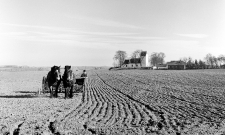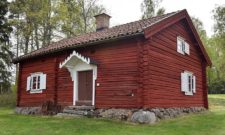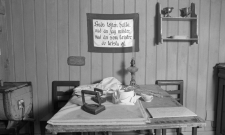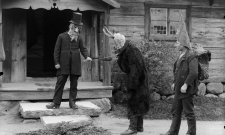Shop our historical maps

Christmas
The booklet "Skånelands historia i Skånelands skolor" was published in 1949 in distribution from Killbergs Bokhandel in Hälsingborg, and was included in the collection "333 års-boken om Skånelandsregionen" published in 1991 by the Foundation Skånsk Framtid.
The newly discovered land
In the latter half of the 19th century, a new land was discovered. Unlike the areas explored at the same time by Livingstone and Stanley, it lay in the interior of Africa. The discoverer was not a bold traveller in distant parts of the world. He was a master craftsman, completely absorbed in his work, and his name was Martin Weibull.
In 1844, Bishop Wilhelm Faxe in Lund founded an association called the Society for the History and Description of Skåne. As a continuation of this, the Association for the Ancient Monuments and History of Skåne was founded in the 1860s. In 1868, this association began publishing the series "Collections for the history, antiquity and description of Skåne", edited by Martin Weibull. Already in the first issue of this, he mentioned his great discovery, the cultural unit he called Skåneland. This includes Halland, Skåne, Blekinge and Bornholm, "these parts of a whole connected by all political, ecclesiastical and social ties", which until the 1650s "had a perfectly common history". For him, this profound cultural landscape unity was a living, inviting reality throughout his active life, to which he devoted his best energies. "Halland, Blekinge and Skåne proper with Bornholm were united by a common law, the Skåne Law, to form the 'Land' of Skåne, a whole that was very prominent in Denmark's earliest history, the centre of which was Lund's county council, where political rights were exercised, while the separate county councils of the parts were responsible for the administration of justice. The ecclesiastical constitution also merged them into a diocese under the common name of Skåne. The Knytling saga already uses this name in its broadest sense: united with Sweden in the Middle Ages (1332-1360), these counties were grouped under the common name "Kingdom of Skåne." Martin Weibull apparently considered it a real mistake to divide the historical presentation of these four sibling counties, which once together made up the entire eastern third of Denmark. He writes:
"Nor can that life be partially represented which has lived and moved as a coherent whole within these common forms of society, and as such has been absorbed into the higher unity of the state, without any mutilation of historical reality.". Even after unification with Sweden "the Scanian counties had a common history, and even in later times, when the development of the state as a whole is eclipsing the development of the countryside, the natural position of the country, its popular culture and customs, the ecclesiastical and legislative divisions still common to most of it, and above all the memory of common destinies, form as many ties of commonality for the four administrative and administrative districts of Halmstad and Carlskrona, Christianstad and Malmöhus counties, into which the old Skåne is now divided.". (Italics by the author.)
Thus, Skåne's pioneering and leading historian could write over eighty years ago. But his words have not yet lost any of their relevance. Even if this landscape, which for lack of a better term we call Skåne Land, is still an undiscovered country by most of its inhabitants, even if it does not play a major role in public consciousness at present, it nevertheless exists as a venerable reality that can never be erased. In particular, it is easily found everywhere in the countryside, in Halland, Blekinge, Skåne and Bornholm. Above all, it characterises our "exceptionally rich folk and popular culture" to use Professor Martin P:n Nilsson's words. Of this we could not say without some pride that it has stood as a solid rock through all ages. To us children of late, it has thus been able to maintain an almost unbroken continuity through centuries and millennia despite all political, religious, national and social changes. It is a sacred heritage that must never be lost. It must be handed down to our children in an enriched form. But in order to know and understand our uniqueness better, in order to realise ever more clearly how precious and inalienable it is, we must return again and again to its source, follow it back to its roots, in other words get to know our past better and better. It was by increasingly strengthening themselves and achieving a cultural renaissance that Norway and Finland, whose history has certain similarities with that of Skåne, learned more and more during the 19th century to become themselves and achieve a new cultural renaissance that is still continuing. One would only wish that as many people as possible in our forgotten region would be given the opportunity to make the same discovery as Martin Weibull.

In search of a book
Yes, it must feel strange in the long run not to really know the country you live in. Anyone who has found our old, interesting Skåne would like others to make the same pleasant discovery. Already in the first issue of "Samlingar till Skånes historia, fornkunskap och beskrivning" it is announced, that "a member has given the Association the opportunity to award a prize of 15 carolins for a satisfactory treatment of one of the following subjects: ... The history of Skåne in a simple and popular presentation for reading in school and at home" . It is expressly stated that the new book "should cover the whole of old Skåne". (Halland, Blekinge, Skåne and Bornholm). Even so, the "pay special attention to the transitional relations in the description of the Swedish history of Skåne". Already at this time, when historical consciousness was slowly awakening in Skåne after nearly two centuries of dormancy, a desirable goal of the first order was thus presented here as a "textbook in the history of Skåne for school use". In the 1923 publication Det Skånska Problemet, which deals exclusively with the question of the historical position of Skåne, it is pointed out as one of the reasons for our present distorted attitude to the history of our ancestral lands, that "The children of Skåne will never have the opportunity to get to know the history of Skåne and the fates and adventures of the Skåne fathers". So here too a textbook is needed.
In the spring of 1928, a writer in Politiken had referred to The Scanian Problem with much recognition. He was sharply contradicted by Professor Bertil Ohlin, who asserted that there was no one in Skåne who shared the ideas of this book and that the students in Lund read it as a joke magazine. Funnily enough, a whole chorus of witnesses emerged shortly afterwards, all clamouring for a popular presentation of the history of our forgotten province. This was done in an inquiry launched by the newspaper Arbetet. Among others, Professor Hans Larsson explained: "The plan to bring about a history of Skåne has my warmest sympathy". Professor Lauritz Weibull writes: "No one can sympathize more than I with the idea of a Scanian history, written for general reading in our settlements". Professor Martin P:n Nilsson's statement is along the same lines: "If any region in Sweden deserves to receive special historical treatment, it should be Skåne, above all, because of the great importance and uniqueness of this province." A similar view is held by the current contractual priest Albert Lysander, the folk school teacher Eric Bladh, the bank master Jöns Nilsson and publishing editor William Lengertz in Malmö, the artist Ernst Norlind in Borgeby, the folk school teacher Nils Westergren in Landskrona, the writer Theodor Tufvesson as a representative of the traditional Österlen, the Baroness Coyet in Torup and the folk school teacher Harald Lindal in Trelleborg. The latter even deserved to win the prize promised in 1868 for a suitable textbook on the history of Skåne. In 1924 his Skånes Historia was published, the second, expanded edition of which could follow in 1930. And although, contrary to the feminist view, he limited his scope to the province of Skåne alone, excluding Halland, Blekinge and Bornholm, and concludes his account with the year 1719, his small, clear, concentrated textbook is of fundamental value. Now at least we have a useful book, a small beginning to something that can grow larger and help us all to remember, to regain for ourselves the land that seemed lost forever.
The school must help
Although school education in the history of our home provinces is not so much mentioned in the Labour Inquiry of the spring of 1928, it is nevertheless clear that those who spoke in it had not least the work of the school in particular in mind. For why should one so ardently desire a popular, compelling presentation of our rich, ancient history, a "Skåne Grimberg", if this were not to be made available above all to the growing youth in our schools? And where could one expect a warmer interest in the teaching of the history of Skåne than among the teachers of Halland, Skåne, Blekinge and Bornholm?
In his previously quoted survey answer in Arbetet, Professor Martin P:n Nilsson emphasises "Skåne's great importance and uniqueness". Baroness Henriette Coyet points out, that we "in all its vicissitudes has borne the provincial character which we have asserted in a great and splendid way". But you can only really understand it when you have seen how it has evolved over time. "Charity begins at home". The young child first feels the connection with home and family, then with the home village and province, and finally with the country to which he belongs and with all humanity. However strongly we may feel the connection with the whole of Sweden's earlier history, even before the years 1645 and 1658, it is only a natural inclination that makes us also want to strengthen the living connection with our own region, with our own ancestors over the centuries. No outside conquest can take away the old land of our fathers. They still stand, our old monuments, and speak to us with their mighty voice from the stone cairns, the giant mounds and the Kivik moat all the way to Varberg Fortress, the ruins of Hammershus, Kristianstad Church, Vidtskövle and Rosendal. At least, it is thought, that it would mean something, that we are not only Swedes or Danes but also Hallanians, Blekingians, Scanians and Bornholmers. That is why it is in the vital interest of all of us, once we have learned to understand what is at stake, that the school should come into action, that our children should get to know and love their own country's past more and more, that they should receive regular instruction in the history of old Skåne.
Yes, schools would help rather than hinder in this area. The way history is still taught in our schools in some places, children may even come to regard their own ancestors as enemies of their country. A sad example of this is given by Baroness Coyet in her reply to an enquiry in Arbetet. There she tells of a Gustav Vasa anniversary, which is celebrated in a small Scanian village school with jubilation over the slain "Jutars" (perhaps more than one of them was Scanian), who were driven into the Brunnbäck river. In his answer to the question, Professor Lysander reminds us that "The exploits of Carl X Gustaf and Erik Dahlberg on the ice of the Belts were a message of sorrow for our fathers". He also points out that "Gustav Vasa, Västerås Riksdag and Olaus Petri had not the slightest influence on the national and religious life of Skåne". In a more jocular article in Stockholms Dagblad in connection with Arbetets enquete, lawyer Carl Romanus points out that "Gustav II Adolf once was really popular in Skåne". And it was, "when it was thought that he had drowned in Lake Vittsjön".
Such statements may seem strange and peculiar to many, whose thoughts are inclined to take other paths. In fact, they point to the objective truth, which may be overlooked and forgotten for a time, but which cannot so easily be completely destroyed. For truth is a spiritual power. The people who lived, worked and fought in Halland, Skåne and Blekinge are our own fathers. We are by no means the descendants of immigrant conquerors. The people are strong who feel the affinity with their fathers. But weak and despicable are the people who try to dissolve the connection with their fathers or even deny them. Who can have respect for such a thing? No one who really loves his old Skåne could wish it to become an abandoned no-man's land, which no one wants to know, which no one asks for, that our ancestors who have done so much for us become fathers without sons, who are completely forgotten by their own children, who never come to light candles or lay flowers on their graves. "Never"says Theodor Tufvesson in Arbetet in the spring of 1928,"the time for publishing the history of Skåne is more appropriate than now. We need that point of reference that our fathers' history gives us - in the midst of a time of confusion. We need all Scanians to get hold of the tradition, which runs through the depths of it, and which we cannot afford to do without."

An inheritance of millions to many heirs
But for such a thing to happen, the knowledge of our country's ancient history must not become the privilege of a few intellectuals but the property of every man. The historical consciousness, which the people of Skåne, to use Henriette Coyet's words, "have long lacked", must be revived. Up to now, our ancient past has been studied mainly by a relatively small group of historically aware and interested people with a core group of road-weary specialist historians. "Scientifically, the material is highly falsified", says Professor Lauritz Weibull. "We now possess an extremely rich material collected", writes folk school teacher Nils Westergren in March 1928.In connection with Arbetets enquete, publisher William Lengertz pointed out how much there is about Skåne in the history of older times. Since then, several years have passed. Even more material has undoubtedly been collected. It is now only a matter of making all this more and more accessible not only to a few scholars but to our whole people. And this can best be done by the fundamental work of the school. Not even the best census book can in the long run do so much for the interests of the home community as a regularly arranged teaching of the missing subject, which then forms an integral part of the school programme and is thus communicated to the people generation after generation.
Skåne's population now exceeds one million people. Its history is both rich and interesting. In the first issue of the journal quoted above, Martin Weibull writes that the history of Skåne "is perhaps precisely because of its own historical intermediate position the richest and most independent of all the Scandinavian provinces, with the possible exception of Schleswig". In his above-mentioned article in Arbetet, his son Lauritz Weibull points out that "Skåne in the Stone and Bronze Ages was at the forefront of cultural development, and that later Lund was for centuries the spiritual centre of Scandinavia". In fact, it is a rare and rich story that we can put into the hands of our children. The beautiful old tales from prehistoric times, which tell of King Skjold and his lineage, the story of Harald Hildetand. "Odin's darling", the building of Dannevirke, the introduction of Christianity, the reign of Canute the Great, the period of the great Lunden archbishops, the popular uprising against Absalon, Andreas Sunesen and Dannebrogen, the struggle between state and church in the late 13th century, the exciting battles of the 14th century, Halmstad, the congress town of the Union period, the drama of the count's feud, Christian II:s life's work, Poul Helgesen's life story, the Lutheran Reformation in Malmö, and the Skåne manor renaissance and its rich flowering. Tyge Brahe's epoch-making scientific works and much, much more.
But on the other hand, there is another fact that is worth noting in this context. If one speaks of "ancient times", of the "eternity" of a nation and the like, it must be borne in mind that virtually none of the countries of present-day Europe is much more than 1000 years old. Among the oldest are Denmark and Sweden. In fact, the people's treasure of ancient memories is quite limited. In native speeches and songs, it is more often than not the same great names, the same ancient treasures, that keep recurring. That is why a people's past is also a priceless treasure, a spiritual capital that is unattainable in the long run, and which one would not too easily allow anyone to deprive or deprive oneself of. It is a common heritage, in which all, the poorest as well as the richest, have an equal share. The recorded history of Skåne before 1650, at least eight centuries, is a wealth for each of us, a heritage that we all have a right to cherish. It is preserved in the writings of scholars. More and more it should be made available to our children. And this is precisely what schools should do. It can help all the children of Skåne to discover their old country.
A topical programme statement
"It can hardly be considered unprofessional", writes Professor Lauritz Weibull, "we believe that the teaching of history in schools, from the lowest to the highest, should be so reorganized that we are no longer excluded from the knowledge of our own past". (Italics by the author.) This is the big agenda item for all Skåne minds right now. Quite recently it has again been stated by leading schoolmen in the newspaper Kvällsposten in Malmö. But if it is to be realised, we must have the support of the schools of Skåne. - For those who have given the matter a little thought, it will be difficult to contradict Professor Weibull's words, not to realise that it is a legitimate demand that we should soon have regular instruction in the history of Skåne in the schools of Skåne.
Subscribe to YouTube:
If you appreciate Allmogens independent work to portray our fine Swedish history and Nordic culture, you are welcome to buy something nice in the shop or support us with a voluntary donation. Thank you in advance!
Support Allmogens via Swish: 123 258 97 29
Support Allmogens by becoming a member
Support Allmogens in your will








